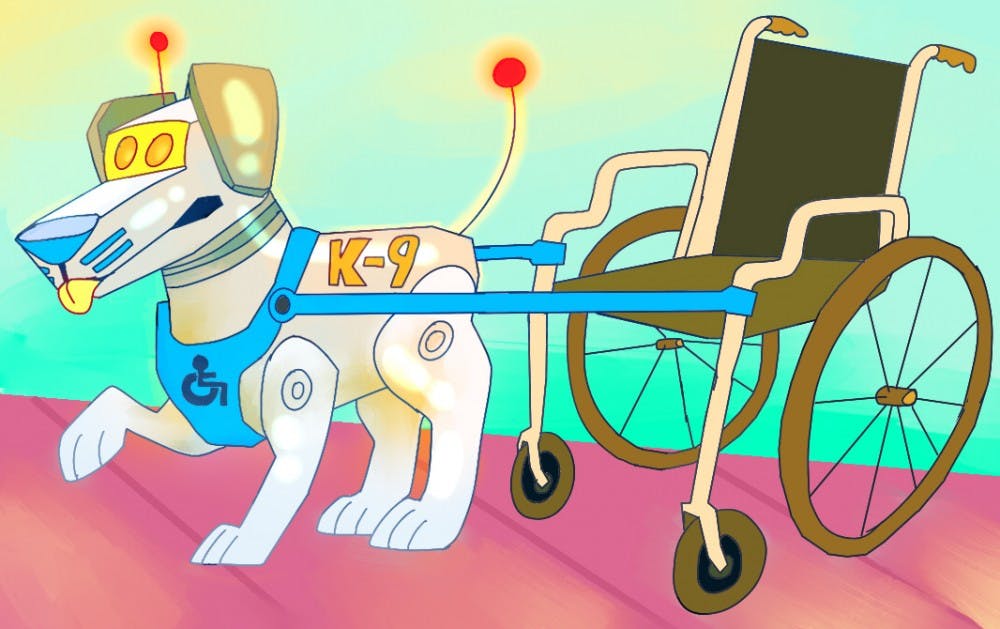A group of students in the Ira A. Fulton Schools of Engineering have created a robotic guide dog that could potentially take the place of a living guide dog in escorting visually impaired individuals.
The students made the invention as part of their capstone project class for their masters program. The class led by Yinong Chen, a senior lecturer at Fulton, required students to select a realistic project to research and create.
“Our main purpose is actually ... education," Chen said. "We created a project for the students to exercise and learn how to do image processing, how to do the voice recognition and how to put different technologies together and to integrate into a system."
The team created a robotic dog and a miniature wheelchair to simulate how the robotic dog would direct and attend to a visually impaired individual, with or without the wheelchair. The team's goal is to get a dog that, when scaled differently, can be used with humans.
"We are more targeted to people who have low vision," Chen said. "The dog will be able to recognize the obstacles and the traffic figures. The dog can give feedback to the person (and) we could design different kinds of feedback ... so they know the situation and what they need to do."
The guide dog is able to understand verbal commands through artificial intelligence, specifically an Amazon Echo, and view its surroundings through a GoPro.
Their robotic dog is able to communicate direction, evaluate hazards and act similarly to a real, living guide dog.
The class is typically two semesters long, with the first semester consisting of research and creating a working prototype of a project. The second semester is when the class continues to perfect their prototype and define their marketing strategy.
This year, the class began early during the summer so that the prototype of the project could be entered into the Intel Cup Undergraduate Electronic Design Contest in Shanghai.
The international contest aims to "encourage improvement of the curriculum structure and content in the disciplines of Information Technology and Electronics, promote implementation of well-rounded education within higher education institutions, and to foster innovation skills amongst students," according to the contest website.
Matthew Koltes, a senior majoring in computer systems engineering, and Stephen Lockhart, a senior majoring in computer science, are two of Chen's students who helped create the robotic dog.
Lockhart was one of two students to attend the contest, which was broken up into two days.
“There was one day of initial judging to decide who would move on in the competition, and on the second day there were two groups of judges that came by and basically decided who was good enough to get first prize and the grand prize," Lockhart said.
All projects entered in the contest were required to use new technology from Intel.
“We were using UP Squared Board, that they are gonna be releasing soon, and so the competition was just to find bugs in the software,” Koltes said.
Thanks to the innovation of the students, they were able to overcome different issues they faced at the competition like synchronizing the dog with the wheelchair — which is complicated because the wheelchair and the dog have different turning rates — and getting the Amazon Alexa software to connect to the Chinese internet.
“Since I was on hardware, getting the dog to walk correctly was one of the major challenges I had, since it would just kind of sit and shift," Koltes said. "It doesn't really walk the same on different surfaces, so we had it on cardboard some of the times and on carpet others so it wouldn't really turn the same amount.”
Even though the team experienced some issues with the robot dog, they were able to walk away from the competition with first prize.
Now that the team has won, they are moving onto the next stages of the class in which they will be fixing various issues like visual recognition and finding a better battery source that will allow the dog to go longer than 20 minutes before needing to be recharged.
Reach the reporter at karichm1@asu.edu and follow @Kellyarichmond3 on Twitter.
Like The State Press on Facebook and follow @statepress on Twitter.





